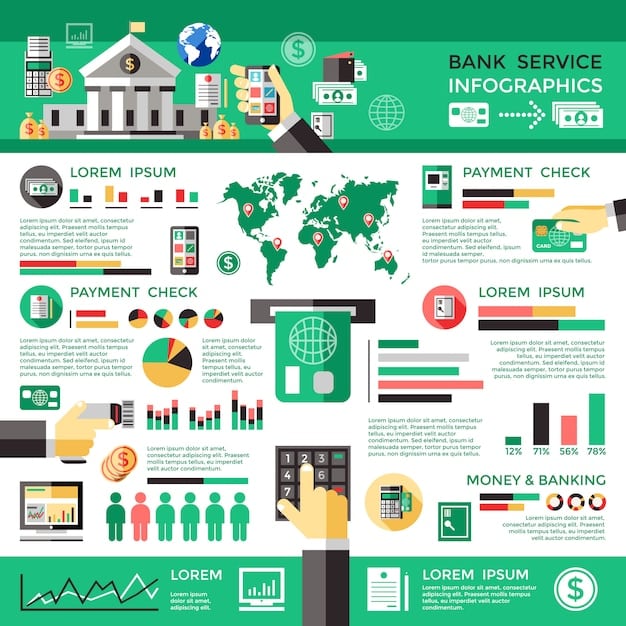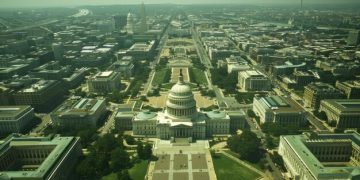Fed Rates Decoded: A Business Owner’s Guide

Navigating the nuances of the Federal Reserve’s interest rate adjustments is critical for US business owners, as these decisions directly influence everything from borrowing costs and consumer spending to investment strategies and overall economic stability.
Understanding the Federal Reserve’s recent interest rate adjustments is paramount for any US business owner looking to thrive in an ever-evolving economic landscape. These decisions by the central bank have far-reaching implications, impacting everything from the cost of capital to consumer demand and investment confidence.
Understanding the Federal Reserve’s Mandate and Tools
The Federal Reserve, often simply called “the Fed,” stands at the helm of the U.S. monetary system, playing a pivotal role in shaping the nation’s economic trajectory. Its primary mission revolves around promoting maximum employment, stable prices, and moderate long-term interest rates. These three objectives are interconnected and serve as the guiding principles for all Fed actions, including the critical adjustments to interest rates.
For a business owner, grasping these foundational principles is not merely academic; it’s essential for strategic planning. When the Fed aims for stable prices, it’s essentially trying to control inflation, which erodes purchasing power and increases operational costs. Maximum employment suggests a healthy economy with robust consumer demand, translating into opportunities for businesses to grow. Moderate long-term interest rates, on the other hand, influence the cost of borrowing for expansion, investment, and even day-to-day operations.
Key Tools at the Fed’s Disposal
The Fed employs several sophisticated tools to achieve its mandate. These tools are often complex, but their impacts ripple through the economy, directly affecting businesses of all sizes.
- The Federal Funds Rate: This is arguably the most publicized tool. It represents the target rate for overnight lending between banks. Changes to this rate indirectly influence other interest rates across the economy, such as those on commercial loans, mortgages, and credit cards.
- Quantitative Easing/Tightening: Beyond the federal funds rate, the Fed engages in large-scale asset purchases (quantitative easing, or QE) or sales (quantitative tightening, or QT). QE injects liquidity into the financial system, lowering long-term rates, while QT withdraws it, typically leading to higher long-term rates.
- Reserve Requirements: Though less frequently adjusted now, the Fed can alter the percentage of deposits banks must hold in reserve. Lowering requirements frees up capital for lending, while raising them restricts it.
- Discount Rate: This is the interest rate at which commercial banks can borrow money directly from the Fed. While less common, it serves as a backstop for banks facing liquidity shortages.
Each of these instruments, when deployed, sends signals to financial markets and, by extension, to businesses. For instance, a hike in the federal funds rate by the Federal Open Market Committee (FOMC) signals a tightening monetary policy, suggesting the Fed wants to cool down the economy, often to combat inflation. Conversely, a rate cut or a period of quantitative easing indicates an accommodative stance, aiming to stimulate economic activity.
Understanding these tools is the first step in decoding the Fed’s actions. It provides a framework for anticipating market reactions and preparing your business for potential shifts in financial conditions. A business owner who understands these mechanisms can better interpret economic news and make more informed decisions regarding capital allocation, pricing strategies, and risk management.

The Mechanism of Rate Adjustments: How They Ripple Through the Economy
When the Federal Reserve announces an interest rate adjustment, it doesn’t immediately change every interest rate in the economy. Instead, it primarily targets the federal funds rate, which is the interest rate at which banks lend to each other overnight. This target then initiates a chain reaction, influencing a wide array of financial products and economic behaviors across the nation.
The first significant ripple occurs in the interbank lending market. As the cost of borrowing for banks changes, they adjust their own prime lending rates – the rate they offer to their most creditworthy customers. This prime rate then forms the basis for many other loans, including business lines of credit, mortgages, car loans, and credit card interest rates. For business owners, this means direct changes to their borrowing costs.
Consider the impact on capital expenditures. A small business planning to purchase new equipment or expand its facilities often relies on loans. If interest rates rise, the cost of financing these investments increases, potentially making some projects less viable. Conversely, lower rates can stimulate such investments, encouraging growth and expansion. These adjustments are not instantaneous but gradually permeate the market as existing loans mature and new ones are issued.
Impact on Consumer Spending and Investment
The Fed’s rate decisions also profoundly affect consumer behavior, which in turn influences business revenues. When rates rise, the cost of borrowing for consumers increases. Mortgage payments become more expensive, credit card debt accrues faster, and car loan interests climb. This can lead to decreased discretionary spending as consumers allocate more of their income to debt servicing, ultimately dampening demand for goods and services.
Conversely, lower rates can spur consumer spending by making borrowing cheaper. People might be more inclined to take out loans for big purchases, refinance mortgages at lower rates, or spend more freely, providing a boost to businesses. This dynamic interplay between borrowing costs and consumer confidence is a critical factor for retailers, service providers, and manufacturers alike.
- Borrowing Costs: Directly impacts the interest rates businesses pay on loans, lines of credit, and bonds.
- Consumer Demand: Influences how much disposable income consumers have and their willingness to take on new debt for purchases.
- Investment Climate: Affects the attractiveness of various investment vehicles, from stocks and bonds to real estate, altering capital flows.
- Exchange Rates: Higher rates can attract foreign capital, strengthening the dollar, making imports cheaper but exports more expensive.
Moreover, interest rate adjustments can influence the stock market and other investment avenues. Lower rates tend to make stocks more attractive relative to bonds, as the cost of capital is lower, potentially boosting corporate profits and valuations. Higher rates can draw investors away from riskier assets like stocks towards safer, higher-yielding bonds. For business owners looking to raise capital through equity or planning for retirement investments, these shifts are significant.
In essence, the Fed’s rate adjustments act as a complex financial lever. Pulling it in one direction or another sets off a series of interconnected market movements, affecting borrowing, spending, and investment patterns. A savvy business owner must not only understand this mechanism but also learn to anticipate its potential timing and magnitude.
Direct and Indirect Impacts on Small and Medium Businesses
Federal Reserve interest rate adjustments carry significant weight for businesses of all sizes, but their effects can be particularly pronounced for small and medium-sized enterprises (SMEs). Unlike large corporations with diverse funding sources and extensive hedging strategies, SMEs often operate with tighter margins and greater reliance on traditional bank lending, making them more sensitive to changes in the cost of capital.
The most immediate and direct impact for many SMEs is on their borrowing costs. Whether it’s a short-term line of credit to manage cash flow, a loan for inventory acquisition, or a long-term mortgage for commercial real estate, these financial instruments are often tied to benchmark rates influenced by the Fed. When rates increase, the cost of servicing existing variable-rate debt rises, and new financing becomes more expensive. This can squeeze profitability and limit opportunities for expansion or investment in new technologies.
Conversely, during periods of lower interest rates, SMEs can access cheaper capital, fostering an environment conducive to growth. They might find it easier and more affordable to secure loans for hiring, expanding into new markets, or upgrading equipment. This direct financial impact is a critical factor in an SME’s strategic planning and operational budgeting.
Beyond Borrowing: Operational and Strategic Considerations
However, the influence of Fed rate adjustments extends beyond just the cost of money. Indirectly, these changes affect the broader economic landscape in which SMEs operate:
- Consumer Demand: As previously discussed, rate changes impact disposable income and consumer confidence. For businesses reliant on consumer spending – from retail to hospitality – a slowdown in demand due to higher rates can directly translate into reduced sales and revenue.
- Supplier Costs: Your suppliers are also subject to the same economic forces. If their borrowing costs rise, they may pass those increases along to you in the form of higher prices for goods and services, affecting your cost of goods sold.
- Competitive Landscape: Your competitors are facing similar pressures. Those with stronger balance sheets or less debt might be better positioned to weather rising rates or capitalize on falling rates, potentially shifting market dynamics.
- Working Capital Management: Higher rates can incentivize businesses to optimize their cash flow and reduce idle cash, as holding cash becomes more expensive due to missed investment opportunities. Efficient management of accounts receivable and payable becomes even more crucial.
For strategic planning, understanding these impacts allows business owners to make proactive decisions. For instance, if the Fed signals impending rate hikes, an SME might consider locking in lower rates on existing variable-rate loans or accelerating planned capital expenditures before borrowing costs become prohibitive. On the other hand, if rate cuts are anticipated, it might be an opportune time to explore refinancing options or strategic investments.
Ultimately, the health and agility of SMEs are closely intertwined with the Fed’s monetary policy. Business owners who closely monitor these signals and understand their multifaceted implications are better equipped to adapt, mitigate risks, and seize opportunities in a dynamic economic environment.
Strategies for Business Owners in a Rising Interest Rate Environment
Operating a business when interest rates are on an upward trend presents a unique set of challenges, but also opportunities for those who are prepared and proactive. The key is to implement robust financial strategies that mitigate the impact of higher borrowing costs and potential shifts in consumer behavior.
One of the most critical steps is to review and optimize your debt structure. If your business has variable-rate loans, consider converting them to fixed-rate options if the current fixed rates are still manageable. This can provide predictability and protect your business from future rate hikes, allowing for more stable budgeting. If conversion isn’t feasible, ensure you have sufficient cash reserves to absorb higher interest payments without jeopardizing operations.
Cash Flow Optimization and Inventory Management
In a rising rate environment, the cost of holding inventory can effectively increase, as the capital tied up in stock could generate more returns elsewhere or incur higher borrowing costs. Therefore, optimizing cash flow and streamlining inventory management becomes paramount.
- Accelerate Receivables: Implement stricter collection policies for accounts receivable to bring cash into the business faster. Consider offering early payment discounts if appropriate.
- Optimize Payables: Strategically manage accounts payable to extend payment terms without damaging supplier relationships, thus retaining cash longer.
- Efficient Inventory: Adopt just-in-time inventory practices where possible to reduce carrying costs and minimize capital tied up in unsold goods.
- Leverage Technology: Invest in inventory management software and supply chain analytics to gain real-time insights and improve forecasting, reducing obsolescence and overstocking.
Beyond internal financial adjustments, businesses should also closely monitor customer demand. If higher interest rates begin to dampen consumer spending, you might need to adjust your sales forecasts, marketing strategies, or even product offerings. This could involve focusing on essential goods or services, enhancing value propositions, or exploring new market segments less sensitive to economic fluctuations.
Another strategic consideration is to carefully evaluate capital expenditure plans. While growth is always desirable, larger investments requiring significant debt financing may need to be re-evaluated for their return on investment in a higher-cost environment. Prioritize projects with the highest potential for immediate returns or those that significantly reduce operational costs, making your business more resilient.

Opportunities and Adjustments in a Declining Interest Rate Environment
While rising interest rates often command detailed strategic planning, a declining interest rate environment presents a different, yet equally impactful, set of opportunities and strategic adjustments for business owners. When the Federal Reserve lowers rates, it typically aims to stimulate economic growth, making borrowing cheaper and encouraging investment and spending.
One of the most immediate benefits is the reduced cost of capital. For businesses with existing variable-rate debt, lower rates translate directly into lower interest payments, freeing up cash flow that can be reinvested into operations, allocated to marketing, or used to build reserves. This reduction in overhead can significantly boost profitability and financial flexibility.
Furthermore, declining rates make it more attractive for businesses to finance new projects or expand. Whether it’s upgrading technology, investing in new production facilities, or acquiring another company, the lower cost of borrowing can make previously marginal projects financially viable. This environment can be a prime time for strategic growth and innovation, allowing businesses to gain a competitive edge.
Refinancing, Investment, and Market Expansion
Business owners should actively explore opportunities to refinance existing debt to lower rates. This applies not only to traditional bank loans but also to commercial mortgages and other forms of financing. Refinancing can significantly reduce long-term interest expenses, improving the company’s bottom line and cash flow position.
- Debt Refinancing: Proactively seek out opportunities to refinance high-interest debts at lower rates, improving cash flow and reducing long-term costs.
- Capital Investments: Evaluate and accelerate planned capital expenditures that require financing, as borrowing costs are more favorable.
- Market Expansion: With improved access to capital and potentially increased consumer demand, explore expansion into new markets, product lines, or customer segments.
- Human Capital Investment: Utilize freed-up capital to invest in employee training, talent acquisition, or retention programs, enhancing productivity and innovation.
On the consumer side, lower interest rates usually stimulate demand. Cheaper mortgages and consumer loans can increase discretionary spending, benefiting businesses across various sectors, especially retail, automotive, and real estate-related industries. Businesses should anticipate this potential uptick in demand and ensure they are adequately staffed and stocked to meet it.
Moreover, a low-rate environment can also influence equity markets, often making stocks more attractive relative to other investments. For business owners considering raising capital through venture capital or private equity, this backdrop can create a more favorable fundraising environment due to increased investor appetite for growth-oriented assets. It’s also an opportune time for entrepreneurs to secure startup funding for new ventures, as the cost of entry may be lower.
However, it’s crucial to exercise prudence. A declining rate environment, while generally positive, can sometimes signal economic weakness that the Fed is trying to counteract. Business owners should balance the enthusiasm for cheaper capital with a realistic assessment of market conditions and potential risks, ensuring any expansion or investment is strategically sound and sustainable.
Forecasting and Hedging: Managing Interest Rate Risk
For any business owner, predicting the precise trajectory of Federal Reserve interest rate adjustments is an inexact science. However, prudent financial management involves more than just reacting to announcements; it requires a proactive approach to forecasting potential movements and implementing strategies to hedge against interest rate risks. This foresight can protect your business from unforeseen volatility and position it for stability.
Forecasting Fed actions involves closely monitoring economic indicators and the narratives presented by Fed officials. Key indicators include inflation rates, unemployment figures, GDP growth, and consumer confidence indices. The Fed’s dual mandate of maximum employment and price stability means that significant shifts in these metrics are often precursors to policy changes. Additionally, paying attention to the minutes from Federal Open Market Committee (FOMC) meetings and speeches by Fed governors can provide valuable clues about their current thinking and future intentions.
While perfect prediction is impossible, a business owner can develop a range of possible scenarios (e.g., rates rising moderately, rates remaining stable, or rates declining) and plan accordingly. This scenario planning helps to identify potential vulnerabilities and opportunities before they fully materialize, allowing for more agile decision-making.
Hedging Mechanisms for Businesses
Once potential interest rate risks are identified, businesses can employ various hedging strategies to mitigate their impact. The choice of hedging instrument often depends on the size of the business, its risk tolerance, and the specific exposure it seeks to manage.
- Interest Rate Swaps: These allow a business to exchange future interest payments with another party, for example, swapping a variable rate for a fixed rate. This can convert variable-rate debt into fixed-rate debt without refinancing the underlying loan.
- Interest Rate Caps: A cap sets a maximum interest rate that a business will pay on its variable-rate debt. If market rates rise above the cap, the provider of the cap pays the difference, effectively limiting the business’s exposure to rising payments.
- Fixed-Rate Debt: As mentioned before, opting for fixed-rate loans from the outset, or refinancing variable-rate debt into fixed-rate debt, is a simple and effective hedging strategy, especially in anticipation of rising rates.
- Diversification of Funding: Reducing reliance on a single type of financing or lender can also act as a form of hedging, distributing risk and potentially providing access to more favorable terms from different sources.
Effective interest rate risk management is not just about protection; it’s also about optimizing capital costs. By strategically hedging, businesses can achieve greater certainty in their financial projections, which is crucial for long-term planning, investor relations, and overall business stability. It requires a deep understanding of financial instruments, an awareness of market dynamics, and a commitment to integrating risk management into core business operations.
The Fed’s Communication and Market Psychology
The Federal Reserve’s influence extends far beyond its direct actions. Its communications, often referred to as “forward guidance,” play a crucial role in shaping market expectations and, consequently, economic behavior. For business owners, understanding the nuances of the Fed’s public statements, press conferences, and official reports is almost as important as understanding the rate adjustments themselves.
The Fed deliberates extensively on its messaging, aiming to be transparent and guide market participants toward its intended policy path. This transparency is designed to reduce uncertainty, allowing businesses and investors to make more informed decisions. However, even subtle shifts in language, tone, or emphasis can send powerful signals that lead to significant market reactions. For instance, a hint about “data dependency” or the “pace of future adjustments” can cause bond yields to fluctuate and stock markets to react decisively.
Market psychology, driven by these communications, can sometimes amplify or even precede the actual economic impact of a rate change. If the market strongly anticipates a rate hike, financial institutions and businesses may begin adjusting their lending rates and investment strategies in advance, effectively pricing in the Fed’s move before it officially occurs. This “preemptive” adjustment is a testament to the power of expectations in financial markets.
Interpreting Fed Signals for Business Decisions
For business owners, learning to interpret these signals can provide a significant advantage. It allows you to anticipate potential shifts in borrowing costs, consumer confidence, and the overall economic climate, giving you time to adjust your business strategy proactively.
- Read Between the Lines: Pay attention not just to what the Fed says, but how they say it. Look for recurring phrases, shifts in emphasis, or any dissenting votes among FOMC members.
- Focus on Economic Outlook: The Fed’s assessment of inflation, employment, and economic growth provides insight into its future policy direction. If the outlook is optimistic, tightening may be on the horizon; if pessimistic, easing might follow.
- Monitor Market Reactions: Observe how bond markets (especially Treasury yields) and equity markets react to Fed announcements. These reactions can indicate how closely the market’s expectations align with the Fed’s current stance.
- Beware of Overinterpretation: While signals are important, avoid overreacting to every minor statement. Focus on the consensus view and the broader trends established over time.
This interplay between official communication and market interpretation creates a dynamic environment. A well-informed business owner uses these signals to fine-tune financial models, reassess risk exposures, and adjust strategic priorities. Ignoring the Fed’s communication is akin to navigating a shipping lane without a lighthouse; you might eventually get where you’re going, but the journey will be fraught with unnecessary peril.
The Broader Economic Landscape: Inflation, Employment, and Geopolitics
While the Federal Reserve’s interest rate adjustments are a critical component of economic management, they do not operate in a vacuum. These decisions are intrinsically linked to, and influenced by, a broader tapestry of macroeconomic factors. For business owners, understanding this larger context—encompassing inflation, employment trends, and global geopolitical events—is crucial for a holistic appreciation of the Fed’s actions and their ultimate impact on business operations.
Inflation, particularly, is a cornerstone of the Fed’s concern. Its mandate for “stable prices” means that when inflation runs hot, the Fed is likely to raise interest rates to cool down the economy and curb price increases. For businesses, high inflation means increased costs for raw materials, labor, and services, eating into profit margins. The Fed’s combat against inflation, through rate hikes, can thus be a double-edged sword: potentially stabilizing long-term costs but increasing short-term borrowing expenses and potentially dampening demand.
Conversely, the employment picture also heavily influences Fed policy. A robust job market, characterized by low unemployment and strong wage growth, can be a sign of a healthy, expanding economy. However, if employment growth is too rapid, it can contribute to inflationary pressures. If, on the other hand, unemployment is high and job growth stagnant, the Fed might lean towards lowering rates to stimulate hiring and economic activity. For businesses, understanding these employment trends helps in forecasting labor costs, talent availability, and consumer confidence.
Geopolitical Events and Global Economic Trends
Beyond domestic economic indicators, global geopolitical events and international economic trends exert increasing pressure on the Fed’s decision-making process. Supply chain disruptions originating from distant conflicts, changes in commodity prices due to international tensions, or major economic shifts in key trading partners can all introduce inflationary pressures or economic slowdowns that the Fed must consider.
For example, a sudden rise in global oil prices due to geopolitical instability can fuel inflation in the US, prompting the Fed to consider rate hikes. Similarly, a recession in a major export market could reduce demand for US goods, potentially leading the Fed to consider easing monetary policy to support domestic growth. These global factors introduce an additional layer of complexity for business owners, especially those engaged in international trade or reliant on global supply chains.
- Inflationary Pressures: Keep an eye on upstream costs, consumer price indices, and wage growth. The Fed’s response to inflation is central to its rate decisions.
- Labor Market Health: Monitor unemployment rates, job openings, and labor force participation. A strong labor market might signal tighter monetary policy.
- Global Commodity Prices: Fluctuations in oil, natural gas, and key metal prices can impact your input costs and influence overall inflation.
- International Economic Stability: Major economic shifts or political events in other powerful economies can create ripple effects that influence US monetary policy.
Integrating these broader economic and geopolitical considerations into your business outlook allows for a more nuanced interpretation of Federal Reserve actions. It transitions you from merely reacting to policy changes to anticipating the forces that drive those changes, enabling more strategic and resilient business planning.
| Key Aspect | Brief Description |
|---|---|
| 📈 Rate Hikes | Increase borrowing costs for businesses and consumers, can reduce inflation. |
| 📉 Rate Cuts | Lower borrowing costs, stimulate economic activity and investment. |
| 🛡️ Hedging | Strategies like fixed-rate debt or swaps to manage interest rate risk. |
| 🗣️ Fed Communication | Crucial for anticipating policy changes and market reactions. |
Frequently Asked Questions About Fed Rate Adjustments
The Federal Reserve primarily adjusts interest rates to achieve maximum employment, maintain stable prices (control inflation), and ensure moderate long-term interest rates. These goals are interconnected, as stable prices and a strong job market are seen as foundations for sustainable economic growth and financial stability in the US.
Rising interest rates directly increase the cost of borrowing for small businesses. This means higher interest payments on new loans, lines of credit, and variable-rate debt. It can make obtaining capital for expansion or even day-to-day operations more expensive, potentially slowing growth and reducing profit margins for businesses reliant on debt financing.
Quantitative easing (QE) is a monetary policy where the Fed buys large quantities of government bonds or other financial assets to inject liquidity into the financial system. This action typically drives down long-term interest rates, making borrowing cheaper and encouraging investment and spending, often used when short-term rates are already near zero.
Businesses can prepare by optimizing their debt structure, such as converting variable-rate loans to fixed rates, and enhancing cash flow management. This involves accelerating receivables, optimizing payables, and improving inventory efficiency. Additionally, re-evaluating capital expenditure plans and increasing cash reserves can help mitigate future impacts.
Yes, Fed rate adjustments significantly affect consumer spending. Higher rates make borrowing for mortgages, car loans, and credit cards more expensive, reducing consumer disposable income and willingness to take on new debt. Conversely, lower rates make borrowing cheaper, stimulating spending and demand for goods and services across the economy.
Conclusion
Decoding the Federal Reserve’s interest rate adjustments is not merely an exercise in financial literacy; it’s an indispensable aspect of strategic business management. For US business owners, these decisions are pivotal, shaping the economic landscape by influencing borrowing costs, investment opportunities, consumer demand, and even global market dynamics. A proactive approach, rooted in understanding the Fed’s mandate, tools, and communication, allows businesses to navigate economic cycles with greater resilience and foresight. By adapting financial and operational strategies in response to these adjustments, entrepreneurs can either mitigate risks in a tightening environment or capitalize on growth opportunities in a period of easing, ultimately securing a stronger and more sustainable future for their ventures.





